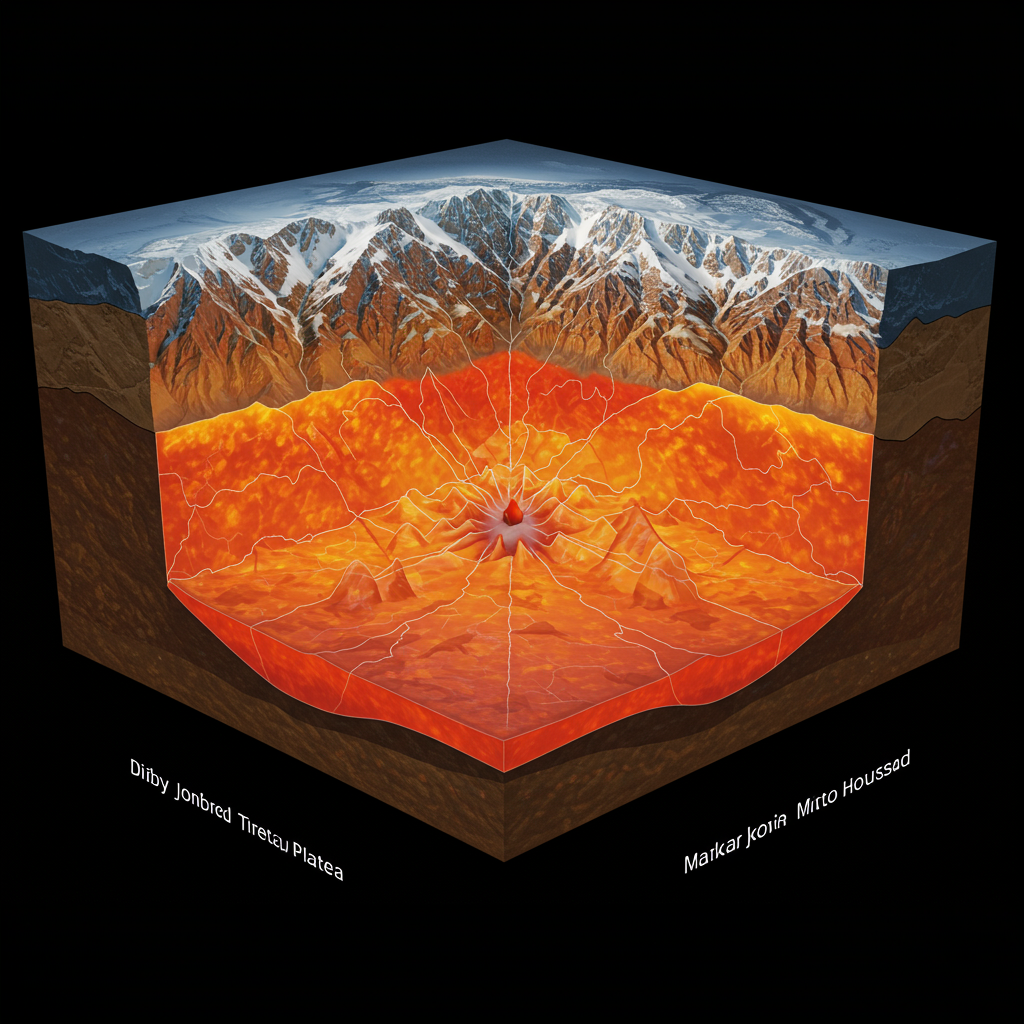For a century, scientists believed the colossal Himalayas and the expansive Tibetan Plateau were supported by a double-thick stack of continental crust. However, groundbreaking new research has revealed a hidden, rigid layer of Earth’s mantle sandwiched deep within this mountainous foundation, fundamentally overturning a 100-year-old geological theory. This discovery, offering an elegant explanation for the unparalleled height and sustained elevation of the world’s highest mountain range, suggests that our understanding of continental collisions and deep Earth dynamics is far more complex than previously imagined.
The Century-Old Mystery of Himalayan Support
The majestic Himalayan mountains, home to Mount Everest, are a testament to Earth’s immense tectonic power. Their formation began approximately 50 million years ago when the Indian subcontinent, an independent tectonic plate, began its colossal collision with the Eurasian plate. This slow-motion, titanic squeeze caused the land to buckle and shorten by hundreds of miles, eventually leading the Indian plate to slide beneath its Asian counterpart, a process known as subduction. This dramatically thickened Earth’s crust in the region, doubling it to an astonishing depth of 45 to 50 miles (70 to 80 km) beneath the Himalayas and the Tibetan Plateau.
For generations, the prevailing geological wisdom, largely based on a 1924 theory by Swiss geologist Émile Argand, posited that this doubled crust alone was sufficient to bear the immense weight of the towering mountains above. The theory, while seemingly robust, contained a fundamental flaw that scientists are only now fully addressing.
A Legacy of Misinterpretation
The issue with the double-crust theory lies in the extreme conditions found deep within Earth. At depths of around 25 miles (40 km), the intense heat and pressure cause crustal rock to become ductile and partially molten—transforming, as lead author Pietro Sternai vividly describes it, “like yogurt.” Building and sustaining a mountain range on such a fluid foundation simply isn’t mechanically plausible.
Despite this logical inconsistency and accumulating evidence suggesting Argand’s theory was erroneous, its appealing simplicity led many geologists to interpret new data within its existing framework. As Sternai noted, “any data that would come along would be interpreted in terms of a single, double-thickness crustal layer.” This highlights how deeply entrenched scientific paradigms can influence observation and interpretation, sometimes for decades or even a century.
Breaking Science: The Mantle “Sandwich” Unveiled
A new study, published in the journal Tectonics, dramatically challenges this long-held view. Led by Pietro Sternai of the University of Milano-Bicocca, researchers employed sophisticated computer simulations to model the continental collision between the Asian and Indian plates. These simulations revealed a crucial, previously unacknowledged component: a piece of Earth’s dense upper mantle strategically positioned between the two colliding crusts.
The model showed that as the Indian plate subducted beneath the Eurasian plate and began to partially melt, blobs of this material did not simply attach to the underside of the Asian crust. Instead, they rose and fused with the base of the lithosphere—Earth’s rigid outer layer, which encompasses both the crust and the uppermost, solid part of the mantle. This forms a robust “mantle sandwich,” providing the mechanical strength necessary to support the colossal weight of the Himalayas.
How the Mantle Provides Strength
The discovery of this mantle insert is profoundly significant because the mantle’s properties are distinct from the crust. It is considerably denser and, crucially, far more resistant to liquefaction at the temperatures that cause crustal rock to become molten. While the buoyant crusts provide the uplift that keeps the region high above sea level, the rigid mantle layer nestled between them offers the essential resistance and mechanical integrity required to prevent the entire structure from collapsing into a molten abyss. As Sternai concisely explained, “You’ve got all the ingredients you need to uplift topography and sustain the weight of the Himalayas and Tibetan plateau.”
The computational findings were not isolated. Researchers rigorously compared their simulation results with existing seismic data and direct rock sample information. Co-author Simone Pilia remarked that “observations that seemed to be enigmatic are actually now more easily explained by having a model where you have crust, mantle, crust.” This convergence of evidence from theoretical models and real-world observations strengthens the new theory’s credibility, making previously puzzling geological oddities in the Himalayas suddenly “make sense.”
The Indian Plate: Tearing Apart Below the World’s Roof
Further complicating the dynamic picture beneath the Himalayas is another astonishing discovery: the Indian Plate itself is actively tearing apart as it collides and subducts. This phenomenon, known as “delamination,” involves the denser lower section of the plate peeling away and sinking into the deeper mantle, challenging assumptions about how continents behave during collisions.
Historically, continents were thought to remain largely intact during such events. However, recent findings, supported by detailed seismic wave analysis and geochemical signatures, reveal a more dynamic and unpredictable nature. Scientists observed unusual patterns in seismic waves beneath Tibet and, critically, found rare helium-3 gas in springs—a tracer for deep mantle rocks—in anomalous locations, suggesting tears in the plate are allowing mantle material to rise.
Seismic Clues and Helium Signatures
Researchers, including Simon Klemperer and his team at Stanford University, used specific isotope signals to identify a distinct geological boundary. They found crust-derived helium south of this line and mantle-derived helium north of it, with an unexpected cluster of mantle-derived helium south of the line near Bhutan. This indicated a fracture in the plate, allowing deep mantle material to ascend. Further earthquake wave studies confirmed this, revealing the lower plate detaching from its upper section and a clear vertical tear along the plate’s western edge, facilitating the upward flow of mantle rock.
This delamination process provides crucial context for the “mantle sandwich” theory. It suggests that the subduction of the Indian Plate is not a simple, uniform slide, but a complex fracturing event that could facilitate the insertion or entrapment of mantle material within the collapsing crustal layers. The varying thickness of the ancient Indian Plate, with a thick continental core and thinner oceanic crust on its sides, likely predisposed it to tearing, as thinner sections rapidly subducted while the thicker middle crashed head-on.
Why This Discovery Matters for Earth Science & Safety
The revelation of the mantle sandwich and the delaminating Indian Plate has profound implications for our understanding of Earth’s geological processes. It fundamentally reshapes models of mountain building and continental collision, suggesting that these events are far more intricate and involve deeper layers of the Earth than previously thought. As geodynamicist Douwe van Hinsbergen noted, “We didn’t know continents could behave this way, and that is, for solid Earth science, pretty fundamental.”
Moreover, these discoveries are not just academic. The tearing of the Indian Plate could significantly increase stress in Earth’s crust, potentially leading to stronger and more frequent earthquakes in the already seismically active Himalayan region. Features like the Cona-Sangri Rift on the Tibetan Plateau are believed to be directly linked to these underground dynamics. Understanding these deep fractures is vital for improving earthquake prediction models and developing effective safety measures for the millions of people living in these high-risk areas.
Revisiting Plate Tectonics: A Dynamic Earth
These new insights into Himalayan geology underscore the revolutionary nature of plate tectonics, a theory that transformed our understanding of Earth much like Darwin’s evolution revolutionized biology. Pioneering work by individuals like Marie Tharp, whose 1957 map of the Atlantic seafloor revealed the Mid-Atlantic Ridge, provided foundational evidence for the idea of a dynamic Earth where continents drift and reshape the planet.
Even today, our planet’s deep interior holds many secrets. Beyond the Himalayas, scientists have detected “secret mountains” — colossal, continent-sized structures known as Large Low Seismic Velocity Provinces (LLSVPs) — located thousands of miles below the crust at the core-mantle boundary. These ancient formations, potentially billions of years old, challenge long-held theories of mantle convection and highlight the ongoing mysteries of Earth’s internal dynamics. The Himalayas, therefore, serve as a living laboratory, continually revealing the extraordinary forces that shape our unique, habitable planet.
Frequently Asked Questions
How does the new theory fundamentally change our understanding of the Himalayas’ support?
The new theory, based on computer simulations and seismic data, overturns a 100-year-old belief that the Himalayas are supported solely by a doubled-thick stack of crust. Instead, it proposes a rigid layer of Earth’s mantle is sandwiched between the colliding Indian and Asian crusts. This “mantle sandwich” provides the necessary mechanical strength and resistance to liquefaction that the crust alone cannot offer at extreme depths, thus explaining how the mountains maintain their immense height despite the crustal rock becoming ductile “like yogurt” deep below.
Where is the Indian Plate observed to be tearing apart, and what evidence supports this?
The Indian Plate is observed to be tearing apart, or delaminating, deep beneath the Himalayas, particularly in regions such as Bhutan. Evidence for this groundbreaking discovery comes from two primary sources: detailed seismic wave analysis, which shows unusual patterns indicative of fracturing, and geochemical signatures from Tibetan springs. Specifically, the presence of rare helium-3 gas, a tracer for deep mantle rocks, in unexpected locations suggests that tears in the plate are allowing mantle material to rise towards the surface, confirming the delamination process.
What are the practical implications of these new geological discoveries, especially for earthquake safety in the Himalayan region?
These new geological discoveries have critical practical implications for earthquake safety in the Himalayan region. The active tearing (delamination) of the Indian Plate creates deep fractures and alters stress distribution within Earth’s crust. This process can significantly increase the likelihood of stronger and more frequent earthquakes, particularly in already seismically active areas like Tibet. Understanding these complex deep-seated processes is crucial for improving earthquake prediction models and developing more effective hazard mitigation strategies for the millions of people living in these high-risk mountainous zones.
Conclusion
The latest scientific revelations surrounding the Himalayas challenge long-standing geological dogma, revealing a far more intricate and dynamic picture of our planet’s interior. The discovery of a rigid mantle layer supporting the world’s highest mountains, coupled with evidence of the Indian Plate actively tearing apart beneath them, underscores that Earth’s geological story is still being written. These insights not only deepen our understanding of monumental events like continental collisions and mountain building but also highlight the critical need for continued research to better predict and mitigate the significant seismic risks faced by communities in these geologically active regions. The Himalayas, in their eternal ascent, continue to inspire awe and unveil the powerful, ongoing processes that shape our remarkable planet.




